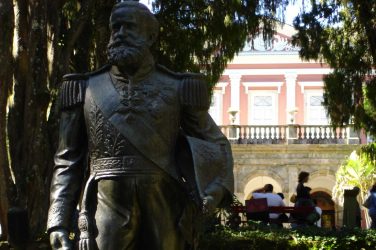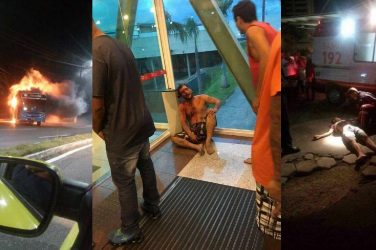The worst environmental tragedy in Brazil’s history occurred on the fifth of November, 2015. Two dams from an iron mine owned by Samarco S.A. – a BHP Billiton and Vale’s joint venture – collapsed, leaving an unprecedented path of destruction.
The tragedy took place in Mariana, located in the heart of the Minas Gerais state, a region whose history was always defined by mining activities. The waste transformed the rural villages of Bento Rodrigues and Paracatu into ghost towns.
Many springs were buried and the Doce River – one of the main waterways in southeastern Brazil – became a sea of mud approximately 850 kilometers wide, beginning at the eastern side of Minas Gerais and crossing all the way through Espírito Santo state until the Abrolhos island.
As result of the complete economic asymmetry between the mining industry and the region in which it operates, the most vulnerable populations are the ones who stand the costs of an environmental tragedy such as the one that took place in Mariana.
Its rural communities took on the cost of a tragedy of unknown proportions as an avalanche of mud invaded their homes, rivers, and communities.
According to the reports submitted by Samarco for the purpose of obtaining the licenses for the dams, the waste would reach 3.5 kilometers in the event of a break.
However, the distance between Mariana and Abrolhos, where the toxic mud was ultimately buried, is 850 kilometers.
Samarco continues to be omnipresent, both politically and economically, in Mariana and its surrounding cities. From the moment their mining operations were suspended in November 2015, RENOVA – a private foundation created by the same companies that causes the damage after an agreement with federal and state (Minas Gerais and Espírito Santo) governments – became the main employer in the region. It should be noted that RENOVA began operations without any prior consultation with the affected population.
RENOVA largely operates in the basin of the Doce River in order to implement reparation programs, designed behind the scenes by the companies responsible (Samarco, BHP Billiton, and Vale), as well as the state authorities involved.
The primacy of corporate interests over those of the affected population is evident within the functional structure of RENOVA. The foundation does not include in its deliberations a representative of the affected peoples, and the majority of its staff come by suggestion of the companies that sponsored RENOVA’s constitution.
In order to understand the dynamic of corporate impunity in Brazil before and after a tragedy like that of November 2015, one should look at the way whereby the mining sector finances electoral processes in all regional scales.
Samarco is the primary donor to election campaigns in Mariana and the surrounding region. As such, there is a strong political support in the local level for mining operations to be reinstated. At the state level, the corporate capture exercised by Samarco, Vale, and other mining businesses has not changed since November 2015.
Weeks after the tragedy, the creation of a Parliamentary Commission in the Legislative Assembly of Minas Gerais was proposed in order to investigate and determine responsibility for the Mariana disaster.
After intense lobbying by the mining sector, the Parliamentary Commission became a “Special Commission for Dams”, supposedly dedicated to the discussion of a new legal framework for the licensing and environmental audit in Minas Gerais.
In this context, the state Prosecutor’s Office elaborated on a draft law endorsed by the citizen campaign called “Mar de Lama Nunca Mais” (Sea of Mud No More). Supported by more than 56 thousand citizens, this draft law (PL 3.695/16) was submitted to the Minas Gerais Assembly with the purpose of establishing more rigorous parameters for the approval of dams within the state.
These parameters would require widespread consultation processes with the communities potentially affected, financial guarantees and insurance for compensation, and the use of safe technologies for containing waste.
If these types of safeguards had existed before November 2015, state authorities would have been able to better enforce Samarco, in order to inform the population about how to respond in case of dam collapse, or similar disasters.
The residents of Bento Rodrigues and Paracatu were never informed of the potential danger of losing their homes to a dam failure, even though the company had been operating in the region for decades.
In fact, some of the people that lost their homes were former employees at Samarco or its contractors, and they also ignored the destruction that could occur after a dam break.
It should be noted that Samarco did not have alarm systems nor evacuation plans, a contributing factor in the death of nineteen people who were buried in the mud that wiped Bento Rodrigues off the map of Minas Gerais and Brazil.
One of the main causes of the Mariana tragedy was the dam design, which has been prohibited in other countries due to its high risk of failure. Known as the “upright” dam, this model has an extension of the containment barrier through several lateral steps, in which the dam grows with the same mining waste as a containment material.
Unfortunately, the preference for a cheaper – but excessively dangerous – model was aggravated by the lack of appropriate institutions, at the federal level, to supervise the dams’ operation in the country.
In 2014, the then National Department for Mineral Production (replaced by the National Agency for Mining in July 2017) supervised only 141 of the 602 mining dams in the country.
The inspection policy after the worst environmental tragedy in Brazil seems to be the obliviousness. According to a recently published report by the National Water Agency, of the 22,290 dams (both from mining and other industries) in the country, only 3,174 have their technical and legal representatives dully identified.
That is to say, there are 19,746 dams – many of which are medium or large in size – for which no one knows who should be legally accountable to those areas affected in the case of dam failure.
The aforementioned report indicates that of the 3,691 installations that have undergone a risk assessment recently, 1,091 are classified as high risk of rupture.
With regard to the potential damage to those inhabiting in the zone potentially impacted by the dams, of the 4,149 dykes examined, 2,053 present a high level of danger due to the toxic nature of the waste or the presence of entire communities or cities where waste may be discharged if the dam fails.
Given a pattern of omissions and lack of due diligence over the years, citizens have tried to influence the public debate so that more responsible construction methods and management of the dams are employed.
In the state of Minas Gerais, for example, 56,000 citizens demanded the adoption of a normative framework that would prevent future tragedies like Mariana under the draft law submitted through popular motion “Lei do Mar de Lama Nunca Mais” (Law of the Sea of Mud No More). However, a different bill is being discussed in the state’s Legislative Assembly (PL 3676/2016).
Although this second bill provides some additional requirements to the current legal framework in force, it is much more permissive than the citizen’s motion under review at the state Assembly.
It is worth remembering that since 1986, at least six mining dam ruptures have occurred in Minas Gerais, totaling 33 deaths and hundreds of thousands affected.
At the federal level, a draft of a Mining Code has been discussed for some years, the text of which was highly criticized by civil society. Not even criticisms from the citizenry, nor the trauma of Mariana, has been sufficient in preventing the toxic relationship between mining companies and the National Congress.
Seventeen of the 34 federal representatives that comprise the main committee of the House of Representatives, which deliberates on the new Mining Code, rely on the support of large mining companies to finance their electoral campaigns.
While this toxic relationship forecasts the future of mining in Brazil, 300 families in Bento Rodrigues and Paracatu remain exposed to degrading living conditions. This statistic reflects only the situation of those individuals from the two villages close to the Samarco dams.
If we examine the entire path of destruction brought about by the irresponsibility of the mining company and the state authorities, the populations of Mariana, Minas Gerais, and all of Brazil should be asking whether the inherent risks of the current mining model are ethical and environmentally acceptable.
Judging by the reactions of the Council of Mariana, the Legislative Assembly of Minas Gerais, and the House of Representatives of Brazil, the answer to this question is very simple: “let’s forget the tragedy of the fifth of November, 2015 and let’s celebrate the development provided by Samarco, Vale, and other companies that finance our electoral campaigns”.
Daniel Cerqueira is a Lawyer, Senior Program Officer at the Due Process for Law Foundation (DPLF). Twitter: @dlcerqueira
Letícia Aleixo is a counselor at the Human Rights Clinic of the Federal University of Minas Gerais and technical advisor to the Ford Foundation in the Samarco case.
Article originally published in GlobalAmericas http://theglobalamericans.org/














